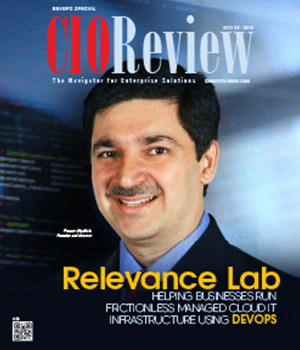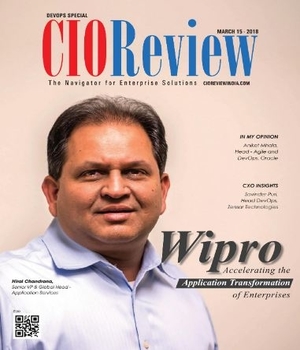
Bringing a Seasonable Balance in Work Culture with DevOps
Mani Kant Singh, Head IT & CISO, ORBIS Financial Corporation Ltd | Wednesday, 21 March 2018, 07:01 IST
 DevOps culture addresses every specific pain points during all phases of software development, be it a soft skill or the technical shortfall.
DevOps culture addresses every specific pain points during all phases of software development, be it a soft skill or the technical shortfall.
Creating a striking balance between development & operations is the call of any businesses today to save time and increase productivity. Imbibition of the DevOps culture helps to do so by forming the thin connecting thread yet an unbreakable collation between the tasks involved in software development by integrating the developers, quality analysts, system admins, and the testers.
DevOps is raising the bar by creating a buzz in the business culture. The seemingly puzzled term ‘DevOps’ is nothing but a truncated term of Development and Operations. And there you decoded the secret of' 'O' in caps.
"The secret behind adopting DevOps culture lies in enhancing the deployment frequency; use the automated tools at each level so as to shorten the lead and market release time"
Well, don’t get exhausted by the thought of upgrading yourself with learning again. [I understand the CIO’s call of duties beyond the time and schedules for new learnings]. This is an enthusiastic learning and there is no much role of additional technology learning here. Simply put, DevOps is not a yet another evolving technology to catch up by allocating schedules of eLearning or weekend learning.
Then what is DevOps?
It is a set culture and practices to integrate the developers and the operations team to improve collaboration and thereby the productivity. The culture is to have a single group of engineers referred as the DevOps engineers committed to end-to-end responsibility in a software development cycle starting from initiation of the project to implementing changes as soon as the end-users revert back with feedback.
The secret behind adopting this DevOps culture lies in enhancing the deployment frequency; use the automated tools at each level so as to shorten the lead and market release time. It is also understood that it reduces the failure rate on new release and fasten the recovery period too. All is attributed to integrated communication and collaboration. Eventually, the team is left with dedicated time for innovation.
Let us move forward and understand the culture in a software development prior to DevOps. Waterfall? Agile methodology?
It was Waterfall methodology and then came the agile methodology. And mention not to say, DevOps is the perfect collation of Waterfall and Agile methodology. It brings in the cross-functional mode of working.
Though waterfall methodology was appreciated as the best systematic approach in development phase, it very soon got considered as inflexible owing to the various shortfalls. To mention a few, they are difficult to follow practically, does not accommodate the natural uncertainty as the program proceeds, long process, development and deployment is high, uptime product maintenance is difficult, no automated management, painstaking process, and the list goes on.
Coming to agile methodology, as you all know, it is an umbrella term used for developing software that includes the scaled agile framework, scrum, lean development, Kanban and/or the extreme programming.
DevOps does not depend on single tool. It uses a toolset or the tool chain mentioned as below:
Source code management tools: to develop, review, and, merge the codes Continuous integration tools: it creates the right status
Continuous testing tools: it is used to gain feedback on business-related risks’
Change management: it is to accommodate the automation and release approval.
Configuration and management of code tools
Monitoring of performance and end-user experience
availing users’ reaction.
And, all these processes involve no human intervention. Everything is an automated process. The single group DevOps engineers meet to initiate the project. They chalk out the plan to create and deploy the software. Thereafter, everything is an automated process done in parallel. The bigger team have the developers, operations, testers, and the support professionals. As the developers write the code, it is automatically deposited in the repository; the operational team deploys the codes; the testers continuously identify the bug; the developers immediately change the codes and fix the bugs; a select number of end-users experiment and comes with response [positive/negative]; accordingly changes are made; monitored for unforeseen shortfalls and stability. Once stable, it is distributed to all the end-users.
Callout traits of DevOps Engineers: DevOps Agile Association [DASA], a community-driven platform is open to the participating members and defines the role-based competencies, the DASA competency model.
They are specialized in:
Knowledge areas: architecture and design; business value optimization; business analysis; test specification; programming; continuous delivery; security, risk, compliance; and infrastructure engineering.
Skill areas: Courage, Team building, DevOps leadership, and continuous improvement.
Advantages and disadvantages of DevOps culture adoption:
• Accelerate the time to market and it shortens the development cycle.
• Faster feedback and A/B testing thereafter helps to build the right product.
• Reduces cost and faster deployment leads to enhanced productivity.
• Impact of bugs is smaller and thus products are more reliable.
• Increased customer satisfaction and thus build trust.
Challenges of DevOps Culture:
The challenges are understood without much emphasis. Adoption of new things always brings in challenges at an organizational level. There arises the necessity of a complete different mindset. The technology cannot be copied as such. It has to blend with the existing processes, people, and the feedback loop. The issues have to be addressed at the individual and organizational level so as to derive the real benefits.
Closing thoughts:
Though DevOps engineers belong to varied IT background, they form the dynamic workforce. Keeping the organization’s future growth and aspirations in mind, they need to follow a plan for betterment across the organization. This can be included in any existing processes and it elevates by removing any specific pain points. And, this culture is here to win as the acceptance level is universal.
CIO Viewpoint
By Anand Kapoor, SVP - Data & Insights at Antuit
Whats The CIO Got To Do With The IOT?
By Sharon Gietl, VP Of Information Technology and CIO , The Doe Run Company
By Zuzar Tinwalla, CIO, Standard Charted Bank India
CXO Insights
Real-Time Engagement (RTE) Technology and its...
By Janifha Evangeline
EON Reality: Empowering Organizations to Reach...
By Shiva Prasad G, Director, EON Reality India
DevOps, DevSecOps Predictions for 2022








